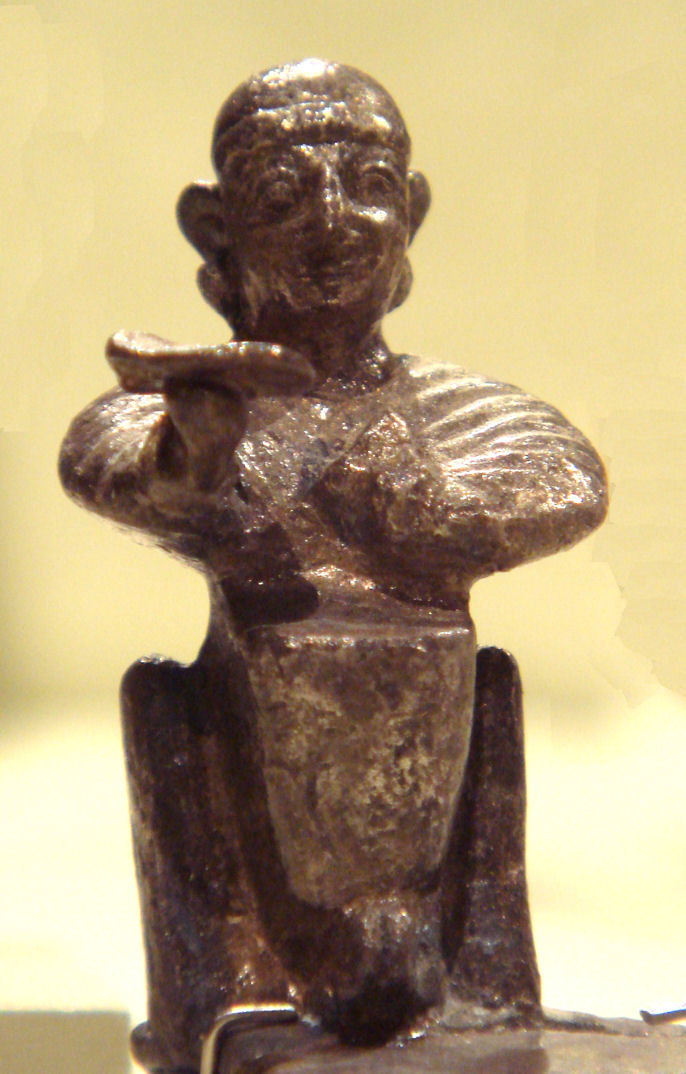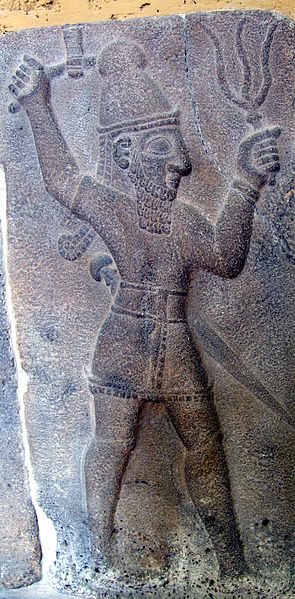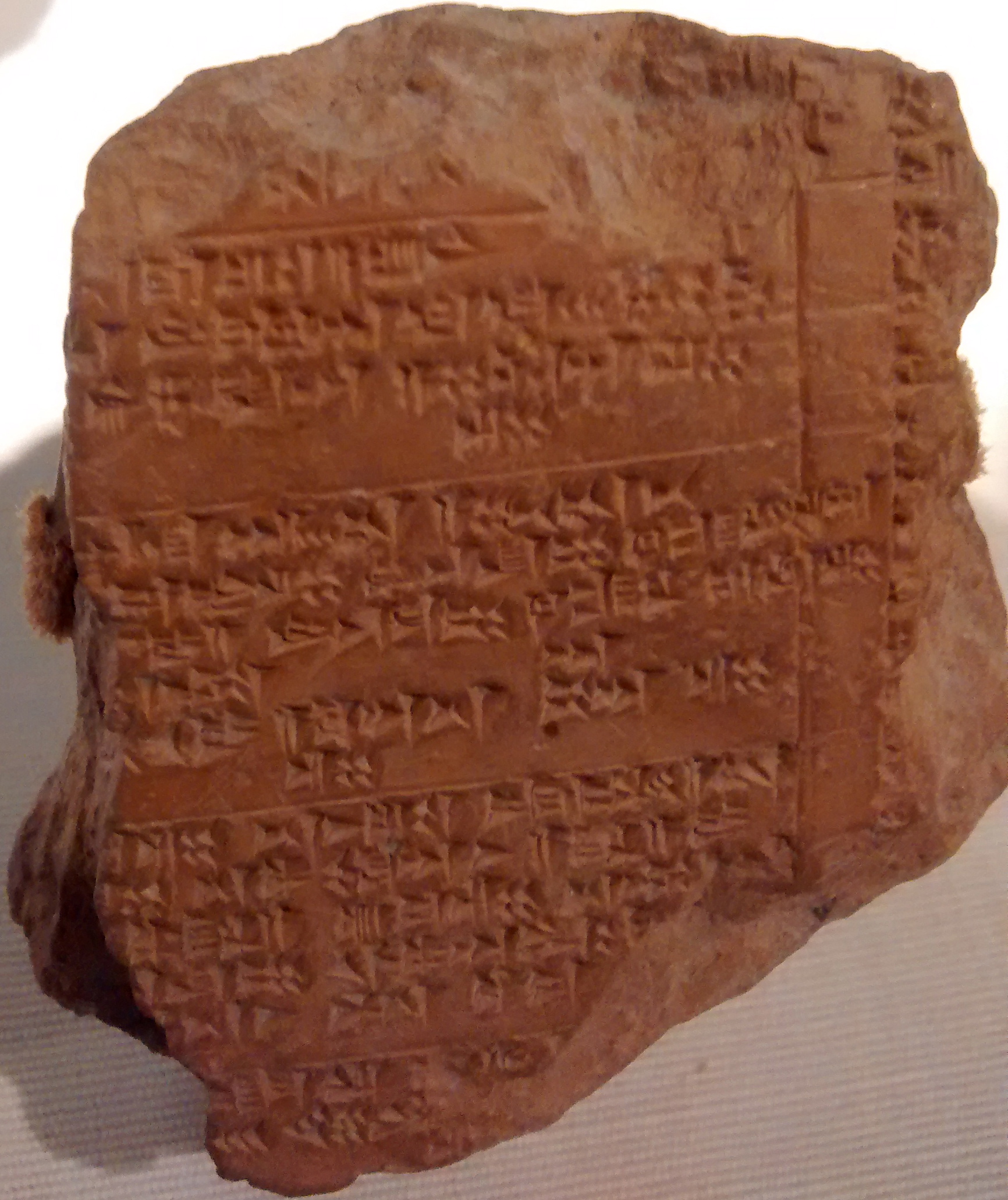|
Tenu (god)
Tenu (also romanized as Tánu) was a Hurrian god regarded as a divine attendant (''sukkal'') of Teshub. He might have originated in a local tradition typical for Aleppo. He appears in a number of Hurrian offering lists ('), as well as Hittite and Emariote texts. Name and character Tenu's name was spelled as '' dte-nu'' or ''dte-e-nu'' in cuneiform. It is also known that he is referenced in a single Hieroglyphic Luwian inscription, though only the first sign of his name is preserved in this context, ''ti''. Tenu was regarded as the divine vizier of Teshub. He was associated with the hypostasis of this god linked with Aleppo. The weather god of this city was originally Adad, but in the second millennium BCE he came to be identified as Teshub instead due to growing Hurrian influence across northern Syria. The relation between Tenu and Teshub is directly described in the text KUB 34, 102+: ''dte-e-nu dte-eéÀ-éÀu-up-pûÙ'' lû¤SUKKAL. Tenu appears in this role in rituals, but in the l ... [...More Info...] [...Related Items...] OR: [Wikipedia] [Google] [Baidu] |
Teshub
Teshub was the Hurrians, Hurrian weather god, as well as the head of the Hurrian pantheon. The etymology of his name is uncertain, though it is agreed it can be classified as linguistically Hurrian language, Hurrian. Both Phonetics, phonetic and Logogram, logographic writings are attested. As a deity associated with the weather, Teshub could be portrayed both as destructive and protective. Individual weather phenomena, including winds, lightning, thunder and rain, could be described as his weapons. He was also believed to enable the growth of vegetation and create rivers and springs. His high position in Hurrian religion reflected the widespread importance of weather gods in northern Mesopotamia and nearby areas, where in contrast with the south agriculture relied primarily on rainfall rather than irrigation. It was believed that his authority extended to both mortal and other gods, both on earth and in heaven. However, the sea and the underworld were not under his control. Depictio ... [...More Info...] [...Related Items...] OR: [Wikipedia] [Google] [Baidu] |
TaéÀmiéÀu
TaéÀmiéÀu (Tashmishu) was a Hurrian god. He was regarded as a brother of Teshub, and it is assumed he had a warlike character. Character Volkert Haas proposed that TaéÀmiéÀu's name was derived from the Hurrian language, Hurrian word ''taéÀmi'', which he translates as strong. The suffix -''éÀu'' is also known from the name of one Teshub's bulls, é eriéÀu, and various Hurrian personal names, such as AnniwaéÀu or EkammeéÀu. TaéÀmiéÀu was one of the multiple warrior gods in the Hurrian pantheon. Other such deities were Ugur (god), Ugur, AéÀtabi, Nergal and áˆeéÀui. In myths, his position appears to be that of a subordinate of his brother Teshub, and in one passage from the ''Song of Ullikummi'' he outright addresses him as "my lord." He served as his sukkal (attendant deity), though as noted by Daniel Schwemer this role in ritual texts could also be attributed to the god Tenu. He proposed that the latter was adopted from the religious tradition of ancient Aleppo, where a month was ... [...More Info...] [...Related Items...] OR: [Wikipedia] [Google] [Baidu] |
Baetyl
A baetyl (; also betyl), literally "house of god", is a sacred stone (sometimes believed to be a meteorite) that was venerated and thought to house a god or deity. The most famous example is the Omphalos stored in the Temple of Apollo at the Greek town of Delphi. The term baetyl was used in ancient Near Eastern sources, in the form of "beth-el", as well as in Greek and Roman sources, as a ''baitylos''. In the former, the term was used to refer to the names of gods or places. Examples include Bethel, a location described in the Hebrew Bible, and the deity Bethel, who was mentioned in texts like Esarhaddon's Treaty with Ba'al of Tyre and the Elephantine papyri. In the latter, the word was used to describe a round stone that had fallen from the sky (i.e. a meteorite). The word ''baetyl'' has taken on a vague use in modern writing. It has been debated both how ancient and modern usage of this word compare with one another. And, among modern historians, concerns have risen over the ... [...More Info...] [...Related Items...] OR: [Wikipedia] [Google] [Baidu] |
Hittite Mythology And Religion
Hittite mythology and Hittite religion were the religious beliefs and practices of the Hittites, who created an empire centered in Anatolia from . Most of the narratives embodying Hittite mythology are lost, and the elements that would give a balanced view of Hittite religion are lacking among the tablets recovered at the Hittite capital Hattusa and other Hittite sites. Thus, "there are no canonical scriptures, no theological disquisitions or discourses, no aids to private devotion". Some religious documents formed part of the corpus with which young scribes were trained, and have survived, most of them dating from the last several decades before the final burning of the sites. The scribes in the royal administration, some of whose archives survive, were a bureaucracy, organizing and maintaining royal responsibilities in areas that would be considered part of religion today: temple organization, cultic administration, reports of diviners, make up the main body of surviving te ... [...More Info...] [...Related Items...] OR: [Wikipedia] [Google] [Baidu] |
Hurrian Deities
The Hurrian pantheon consisted of gods of varied backgrounds, some of them natively Hurrian religion, Hurrian, while others adopted from other pantheons, for example Religion in Ebla, Eblaite and List of Mesopotamian deities, Mesopotamian. Like the other inhabitants of the Ancient Near East, Hurrians regarded their gods as anthropomorphic. They were usually represented in the form of statues holding the symbols associated with a specific deity. The YazáÝláÝkaya sanctuary, which was Hittites, Hittite in origin but served as a center of the practice of Hurrian religion, is considered a valuable source of information about their iconography. Hurrians organized their gods into lists known as ''kaluti'' or into similar lexical lists as the Mesopotamians. The formal structure of the pantheon was most likely based on either Mesopotamian or Syrian theology. The status of individual deities and composition of the pantheon could vary between individual locations, but some can nonetheless be ... [...More Info...] [...Related Items...] OR: [Wikipedia] [Google] [Baidu] |
Hattusa
Hattusa, also Hattuéa, áˆattuéÀa, Hattusas, or Hattusha, was the capital of the Hittites, Hittite Empire in the late Bronze Age during two distinct periods. Its ruins lie near modern Boáazkale, Turkey (originally BoáazkûÑy) within the great loop of the KáÝzáÝláÝrmak River (Hittite: ''Marashantiya''; Greek: ''Halys River, Halys''). Charles Texier brought attention to the ruins after his visit in 1834. Over the following century, sporadic exploration occurred, involving different archaeologists. The Deutsche Orient-Gesellschaft, German Oriental Society and the German Archaeological Institute began systematic excavations in the early 20th century, which continue to this day. Hattusa was added to the List of World Heritage Sites in Turkey, UNESCO World Heritage Site list in 1986. History The earliest traces of settlement on the site are from the sixth millennium BC during the Chalcolithic period. Toward the end of the 3rd Millennium BC the Hattian people established a settle ... [...More Info...] [...Related Items...] OR: [Wikipedia] [Google] [Baidu] |
YazáÝláÝkaya
:'' YazáÝláÝkaya, Eskiéehir, also called Midas City, is a village with Phrygian ruins.'' YazáÝláÝkaya () was a sanctuary of Hattusa, the capital city of the Hittite Empire, today in the ûorum Province, Turkey. Rock reliefs are a prominent aspect of Hittite art, and these are generally regarded as the most important group. History This was a holy site for the Hittites, located within walking distance of the gates of the city of Hattusa. It had two main chambers formed inside a group of rock outcrops. Access to the roofless chambers were controlled by gateway and building structures built right in front of them, however only the foundations of those structures survived today. Most impressive today are the rock reliefs of Chambers A and B portraying the gods of the Hittite pantheon. One of the uses of the sanctuary may have involved the New Year's celebrations ceremonies. A 2019 journal article by Rita Gautschy and Eberhard Zangger suggested that the place may have served as a ti ... [...More Info...] [...Related Items...] OR: [Wikipedia] [Google] [Baidu] |
Catalogue Des Textes Hittites
The corpus of texts written in the Hittite language consists of more than 30,000 tablets or fragments that have been excavated from the royal archives of the capital of the Hittite Kingdom, Hattusa, close to the modern Turkish town of Boáazkale or BoáazkûÑy. While Hattusa has yielded the majority of tablets, other sites where they have been found include: Maéat HûÑyû¥k, OrtakûÑy, KuéakláÝ or KayaláÝpáÝnar in Turkey, Alalakh, Ugarit and Emar in Syria, Amarna in Egypt. The tablets are mostly conserved in the Turkish museums of Ankara, Istanbul, Boáazkale and ûorum (OrtakûÑy) as well as in international museums such as the Pergamonmuseum in Berlin, the British Museum in London and the Musûˋe du Louvre in Paris. The corpus is indexed by the ''Catalogue des Textes Hittites'' (CTH, since 1971). The catalogue is only a classification of texts; it does not give the texts. One traditionally cites texts by their numbers in CTH. Major sources for studies of selected texts themsel ... [...More Info...] [...Related Items...] OR: [Wikipedia] [Google] [Baidu] |
Ninegal
Ninegal (also spelled Ninegalla) or Belat Ekalli (Belet-ekalli) was a Mesopotamian goddess associated with palaces. Both her Sumerian and Akkadian name mean "lady of the palace." From Mesopotamia the worship of Ninegal spread to Elam in the east and to Syria and the Hittite Empire in the west. She was particularly venerated in Mari and Qatna, and due to her presence in the pantheon of ancient Syria she was also incorporated into Hurrian religion. The Hurrians transcribed her name as Pentikalli (Pendigalli). Especially in literary works, Ninegal could function as an epithet of Inanna, and they could be also associated with each other in other contexts. However, it is now generally assumed that they were distinct deities in origin. Additionally, Ninegal could be associated with the goddess of prisons, Nungal. Character While in the past it has been proposed that Ninegal was a form of Inanna in origin, or, as argued by Thorkild Jacobsen, that the name designated Inanna in a pr ... [...More Info...] [...Related Items...] OR: [Wikipedia] [Google] [Baidu] |
Kingdom Of Khana
The Kingdom of áˆana (KUR á¨a-ni-i "Land of áˆana"; Khana) was the Syrian kingdom from Hana Land in the middle Euphrates region north of Mari, which included the ancient city of Terqa. The kingdom was a successor to the Kingdom of Mari and emerged during the decline of the First Babylonian Dynasty. A newer view is that only the initial six rulers lived during that time and that after an interregnum, Khana re-emerged in the Middle Babylonian period under the last six kings. The Low Chronology dating scheme for Hana has gained much support. The kingdom was located in the middle Euphrates close to the junction of Khabur River. Its capital was the town of Terqa or possibly SaggarûÂtum. Location The kingdom of Hana was located on territories formerly ruled by the sovereigns of Mari. The rulers of Mari held the title "King of Mari, Tuttul and the land of Hana". Since Mari was abandoned after its destruction by Hammurabi in (middle chronology) and Tuttul certainly was not part ... [...More Info...] [...Related Items...] OR: [Wikipedia] [Google] [Baidu] |
é eri And áˆurri
é eri and áˆurri were a pair of theriomorphic Hurrian gods who almost always appear together in known sources. They were believed to pull the chariot of TeéÀéÀub, the Hurrian weather god. é eri additionally could function as a deity mediating between petitioners and his master, but no individual role was ever assigned to áˆurri. In addition to appearing in Hurrian offering lists and theophoric names, for example from Nuzi, é eri and áˆurri are also attested in Hittite and Mesopotamian sources. While the Hittites incorporated them into their pantheon alongside TeéÀéÀub and other deities from his circle, in Mesopotamia they instead came to be associated with Adad. Names é eri and áˆurri almost always occur as a pair in known texts. In oldest sources, the spellings of the names were é áriéÀ (or é erriéÀ) and áˆurra, but later the forms é eri (é erri) and áˆurri predominate. In Emar, the forms HurraéÀ and é eliéÀ are attested. A number of unique variants have also been ident ... [...More Info...] [...Related Items...] OR: [Wikipedia] [Google] [Baidu] |




